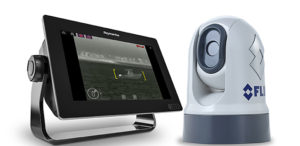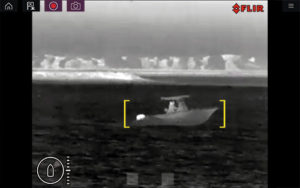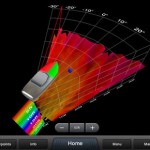After taking a pause last year due to the Covid-19 pandemic, the largest boat show in the world was back last week with a new name – the Discover Boating Miami International Boat Show – as well as some exciting new marine electronics products.
While we were not in attendance, we have reviewed the news reports and supplier press releases on some of the newest and most exciting marine electronics offerings and think any of the following might be of interest for Connecticut boat owners looking to upgrade electronics systems on their vessels.
Garmin Boat Switch
Does a digital switching solution that integrates up to 20 output circuits and 7 sensor inputs sound appealing to you? What if we said with the new Garmin Boat Switch, boat owners can dim lights, toggle lights on and off, operate horns, monitor fuel or water tanks, and even regulate livewell water pumps with a built-in timer to keep fish alive all from a screen on their chartplotter?
 Garmin’s new Boat Switch is an integrated switching solution that lets you customize and then monitor and or operate up to 20 circuits from your compatible Garmin GPSMap or EchoMap chartplotter. Instead of having to find and manipulate physical buttons or switches, you can just bring up the Boat Switch view on your chartplotter and operate a horn, bring up cabin lights or check critical system status.
Garmin’s new Boat Switch is an integrated switching solution that lets you customize and then monitor and or operate up to 20 circuits from your compatible Garmin GPSMap or EchoMap chartplotter. Instead of having to find and manipulate physical buttons or switches, you can just bring up the Boat Switch view on your chartplotter and operate a horn, bring up cabin lights or check critical system status.
It offers four different switch types, including on/off for bilge pumps and nav lights, press-and-hold dimmers for cabin lights, momentary outputs for horns, and timers to circulate your livewell pumps. Plus, it provides a built-in tank sender detection and calibration for up to four tanks — including fuel, water, and gray water. It installs without special tools and allows you to easily add and name switches on your chartplotter display. Learn more at Garmin.com
Raymarine Cyclone Radar
Winner of the Editor’s Choice Award in the Bonnier 2022 Best Elex Awards program, as well as the NMMA Consumer Electronics award for best mobile application, the Raymarine Cyclone chirp pulse-compression solid-state radar series is a somewhat radical open-array scanner with the profile of an aircraft wing.
Designed for a wide range of vessels, the scanners are just over 13 inches tall and weigh 51 pounds. They also sport an aerodynamic design that allows operation in wind speeds up to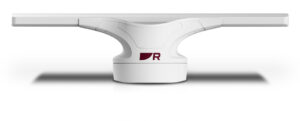 100 knots. The aptly-named Cyclone is offered with 3-, 4- or 6-foot antenna arrays and with either a 55-watt/6 kW-equivalent or 110-watt/12kW-equivalent pedestal and variable rotation speeds up to 60 rpm.
100 knots. The aptly-named Cyclone is offered with 3-, 4- or 6-foot antenna arrays and with either a 55-watt/6 kW-equivalent or 110-watt/12kW-equivalent pedestal and variable rotation speeds up to 60 rpm.
The system features both Doppler and conventional scan modes, as well as RangeFusion technology that enables Cyclone to combine short- and long-range pulses into a single high-clarity image that requires only one pane to view. A 50-target ARPA target tracking system comes standard on all models. Cyclone models network seamlessly with Raymarine Axiom, Axiom+, Axiom Pro, and Axiom XL chartplotter multifunction displays. Learn more about this offering at Raymarine.com.
SiOnyx Nightwave D1
On even the darkest nights, the new Nightwave D1 from SiOnyx will help you visualize hazards to navigation from as far away as 150 yards. Nightwave D1 is an affordable, compact fixed-mount camera that utilizes SiOnyx’s patented Black Silicon CMOS sensor designed to allow mariners to easily spot obstacles and debris in moonless starlight without white light or pricier thermal cameras.
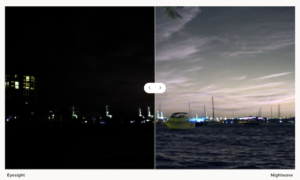 Generating color images in 1080p, Nightwave requires only faint starlight as the sole illumination source to help boaters see and identify low-lying hazards such as timber or lobster-pot buoys within its 40-degree field of view.
Generating color images in 1080p, Nightwave requires only faint starlight as the sole illumination source to help boaters see and identify low-lying hazards such as timber or lobster-pot buoys within its 40-degree field of view.
The IP67-waterproof-rated Nightwave camera is compact; just five inches in diameter and six inches tall and weighs just under two pounds. Designed to mount on hardtop in top-up or top-down configurations, the system also has a ¼-inch 20-thread receiver for using the camera with a Ram mount. In addition to Wi-Fi video streaming to a variety of mobile devices using the SiOnyx Nightwave app, it can also be hardwired to the video port in most multi-function displays. Learn more at SiOnyx.com or watch this video of the system in action.
Furuno Compact Dome Radar
If you are looking for big radar functionality in a compact footprint, the newest Furuno NXT 19” dome radar is for you. The Furuno DRS2DNXT is compatible with the brand’s popular NavNet TZtouch, TZtouch2, or TZtouch3 MFDs and includes all the same features and modes found in the larger 24-inch NXT, including Furuno’s Target Analyzer.
Using NXT solid-state Doppler technology, Target Analyzer possesses a 48-nautical-mile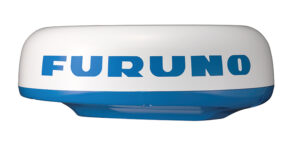 range and includes Furuno RezBoost, which sharpens target returns and allows this compact system to achieve the equivalent resolutions of a larger antenna array.
range and includes Furuno RezBoost, which sharpens target returns and allows this compact system to achieve the equivalent resolutions of a larger antenna array.
Anglers will appreciate bird mode in this new compact radar array, which automatically adjusts gain and clutter to detect flocks or even individual birds feeding on baitfish. Learn more about the DRS2DNXT at Furunousa.com
If you have questions or would like to discuss marine electronics upgrades for your vessel, please contact DG Fitton of Marine Special Products Group. DG would be happy to talk with you about upgrading or refitting the marine electronics on your vessel. What’s more, if you are interested in data connection solutions, we have a big announcement in this regard coming soon – watch this space!
